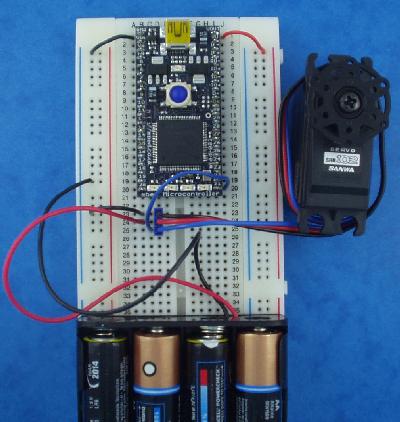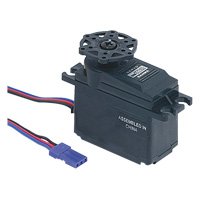R/C Servo
Radio Control style servo motor
Hello World
Import programServo_HelloWorld
Example to sweep a servo through its range
Library
Import libraryServo
A class to control a model R/C servo, using a PwmOut
Notes
This library controls a standard R/C model servo using a PwmOut signal, and provides control of the servo between min and max by setting it to 0.0 - 1.0.
As all servos respond differently, you can also use the calibrate function the range, so 0.0 - 1.0 is the maximum range of the servo.
Details
The underlying PwmOut period is set to 20ms, and by varying the pulsewidth (up to a maximum of 0.5ms to 2.5ms) the position of the servo is changed, usually by around 180 degrees. The library lets you calibrate the exact range.
The servo must connect to a PwmOut, and be supplied with a separate power supply, usually in the range 4.5-6.0v.
Warning
A servo requires higher current than the USB port can safely provide, and so it is essential that you power the servo using an external supply, such as a 4xAA (6v) battery pack or an appropriate DC power adaptor.


Examples
Import program
00001 #include "mbed.h" 00002 #include "Servo.h" 00003 00004 Servo myservo(p21); 00005 Serial pc(USBTX, USBRX); 00006 00007 int main() { 00008 printf("Servo Calibration Controls:\n"); 00009 printf("1,2,3 - Position Servo (full left, middle, full right)\n"); 00010 printf("4,5 - Decrease or Increase range\n"); 00011 00012 float range = 0.0005; 00013 float position = 0.5; 00014 00015 while(1) { 00016 switch(pc.getc()) { 00017 case '1': position = 0.0; break; 00018 case '2': position = 0.5; break; 00019 case '3': position = 1.0; break; 00020 case '4': range += 0.0001; break; 00021 case '5': range -= 0.0001; break; 00022 } 00023 printf("position = %.1f, range = +/-%0.4f\n", position, range); 00024 myservo.calibrate(range, 45.0); 00025 myservo = position; 00026 } 00027 }
An Introduction to RC Servos has more background information on RC Servos.
You need to log in to post a discussion


